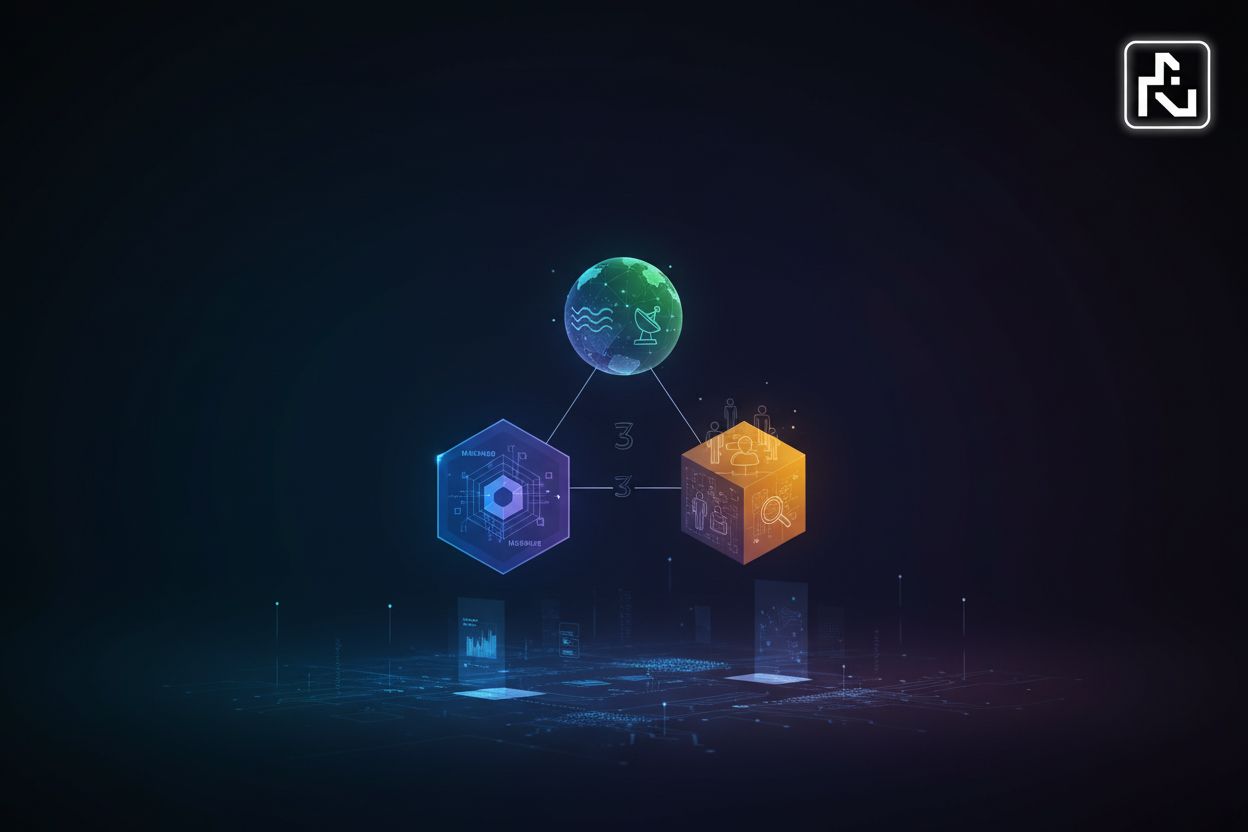What Is Digital Transformation? Definition & Overview
TL;DR
Defining Digital Transformation: More Than Just a Buzzword
Okay, so digital transformation – it's way more than just slapping some new tech on old systems, right? It feels like everyone's talking about it, but what does it actually mean for your business, and why should you even care?
Digital transformation is basically about weaving digital tech into everything you do as a business. It's not just about updating your website or moving to the cloud—though those things can be part of it. Red Hat defines it as fundamentally changing how you operate and deliver value.
Think of it as a total revamp. It's not just tweaking existing processes, but rethinking them from the ground up. For example, a hospital might not just digitize patient records (that's digitization), but also use ai to predict patient flow, personalize treatment plans, and even offer remote monitoring services.
It's about culture, too; it requires a mindset of constant questioning and a willingness to shake things up. It means being okay with trying new things, even if they don't always pan out. As Red Hat also notes, it's a cultural change that requires organizations to continually challenge the status quo, experiment, and get comfortable with failure.
Experimentation is key. Companies need to be willing to try new things, even if they fail. Think of a retail chain using ai to personalize product recommendations in real-time or a bank using blockchain to streamline international transactions.
It's easy to get these terms mixed up, but they're not interchangeable.
Digitization is simply converting analog stuff (like paper records) into digital formats. Think scanning documents into pdfs.
Digitalization is using that digital data to make existing processes more efficient. So, instead of filing those pdfs in a cabinet, you're storing them in a searchable database.
Digital transformation, on the other hand, is about rethinking those processes entirely and creating new value. Instead of just storing those pdfs, you're using them to automate workflows, personalize customer interactions, and even develop new products or services.
Seriously, in today's world, it's not optional. It's like the business version of "adapt or die." According to McKinsey, about 90 percent of organizations are undergoing some kind of digital transformation.
Digital transformation is imperative for all businesses, from the small to the enterprise.
It's about being agile and able to pivot quickly when the market changes. Think of a restaurant chain that suddenly had to shift to online ordering and delivery during the pandemic.
Consumer habits are changing faster than ever, and businesses need to keep up. I mean, who even uses cash anymore?
Basically, if you're not embracing digital transformation, you're gonna get left behind. Plain and simple.
So, that's digital transformation in a nutshell. It’s about more than just tech – it’s a fundamental shift in how businesses operate and create value. Now, let's dive a bit deeper and look at some of the benefits that come with successfully transforming your business.
The Driving Forces Behind Digital Transformation
Okay, so you're probably wondering what's making companies jump on this digital transformation bandwagon, right? It's not just hype—there are some real driving forces behind it.
Customers today, they kinda expect everything now, and they want it personalized. It's like, if you can't deliver a seamless experience across all your digital touchpoints, they'll just bounce.
Think about it: people want 24/7 access. They wanna be able to hit up your website, app, or social media at any time and get what they need, whether it's answers to questions or making a purchase. if a company doesn't offer support when needed, that could be a big problem.
Personalization is key too, nobody wants generic anymore. They want you to know them and treat them like individuals, not just another number.
It's not just customers, employees expect more too. They want user-friendly digital tools in the workplace that makes their job easier.
Collaboration is huge. Employees needs to be able to easily connect with each other and access the information they need to do their jobs effectively.
Flexibility is another one. Digital transformation empowers employees to work from anywhere, anytime.
Technological advancements are playing a huge role in driving digital transformation. These technologies are not just buzzwords – they are fundamentally changing industries and creating new possibilities.
ai is automating tasks, from customer service chatbots to predictive maintenance in manufacturing. It's also providing valuable insights that helps businesses make better decisions.
The internet of things (iot) is connecting devices and generating data, which can be used to improve everything from supply chain management to personalized healthcare.
Think about the retail industry. Instead of just having a website, retailers are now using ai to personalize product recommendations, offer targeted promotions, and even provide virtual shopping experiences.
def recommend_products(customer_data):
# AI algorithm to analyze customer data (purchase history, browsing behavior)
recommended_products = ai_algorithm(customer_data)
return recommended_products
As mentioned earlier, an estimated 90 percent of organizations are undergoing some kind of digital transformation, according to McKinsey research. But it's not enough to just adopt new technologies; it's important to have a clear strategy and a willingness to change your culture.
So, those are some of the key forces driving digital transformation. Next up, we'll take a look at some of the benefits that come with embracing this shift.
Digital Transformation in Action: Examples Across Industries
Ever wonder how those big companies are actually using all this digital transformation stuff? It's more than just talk, I promise! Let's peek behind the curtain and see some real-world examples.
Digital marketing has totally flipped the script, right? It's not just about blasting out generic ads anymore.
Now, it's about personalized messaging and targeted campaigns. Think of getting an email with a coupon for your favorite coffee order - not bad, huh?
Marketing automation tools are great for streamlining things and making everything more efficient. No more manually sending emails to thousands of customers!
And data analytics? Forget about it! It's provides super valuable insights into what customers are actually doing and how well those campaigns are performing.
Social media marketing is great because you can talk directly with customers. It's like having a conversation instead of just shouting from the rooftops.
Sales has changed a ton, too. It's not just about cold calling and hoping for the best anymore - thank goodness!
crm systems provides a single place for all your customer stuff. It's just great to have everything in one spot!
ai-powered tools can find leads and even predict outcomes. It's like having a crystal ball, but, you know, with data.
Social selling is pretty neat for building relationships and drumming up leads. It's like networking, but online.
And mobile sales apps? Dude, they let sales reps sell from anywhere.
Customers expect support on all channels now. If they can't get help on their phone (or whatever), they're gonna get annoyed.
They want support on phone, email, chat, even social media--whatever works for them. The more the better!
Self-service portals are great for customers. They can find answers themselves, without even talking to anyone.
Chatbots are pretty good - they can give instant support and answer easy questions.
And ai-powered routing can send tricky problems to the right people. No more bouncing around between departments!
Banking has gone completely mobile. I mean, who even goes to a bank branch anymore?
Mobile banking apps are so convenient. You can do everything from your phone!
Digital payment systems, like Apple Pay, are pretty handy, too. I never carry cash anymore!
Online banking is great for 24/7 access. You can check your balance at 3 AM if you really want to!
And ai-powered fraud detection keeps your money safe. Nothing worse than getting your account hacked.
E-commerce has obviously changed retail. But it's about more than just selling stuff online.
e-commerce platforms can expand your reach. You can sell to the whole world!
Personalized recommendations really make the shopping experience better. It's like having a personal shopper.
Loyalty programs and mobile apps can reward customers for coming back. Everyone likes a good deal!
And iot sensors can keep track of inventory. No more running out of stuff!
Insurance is getting smarter, too.
iot devices can track driving habits and reward safe drivers. Good drivers get discounts, that's a win-win.
Online portals can make it easier to manage policies and file claims. No more paper forms!
Data analytics can spot fraud and improve how risk is assessed. Saves the insurance company money, and keeps rates low.
And ai-powered chatbots can help customers with questions and claims. Faster than talking to a human, sometimes.
According to eweek, digital transformation is about finding new markets and new ways of doing business. It's about using new tech to do things that've never been done before.
So, as you can see, digital transformation is happening everywhere. It's not just about one thing – it's a whole bunch of things working together. Now, let's talk about the benefits you can get from all this digital transformation stuff.
Crafting Your Digital Transformation Strategy: A Step-by-Step Guide
Alright, so you've been hearing about digital transformation, seeing what it looks like in the wild, and maybe you're thinking, "Okay, how do I actually do this?" It's not just about throwing money at tech; it's about a plan, a real strategy.
First things first: gotta figure out where you're at now. Think of it like planning a road trip; you need to know your current location before you can punch in the destination.
- Take a good hard look at your business, inside and out. What's working? What's a pain in the butt? What are your customer saying? Don't just guess, actually ask them. If your customer service team is constantly dealing with the same complaints, that's a sign.
- What tech are you already using? is it ancient, duct-taped together, and barely functional? Or is it relatively modern and just not being used to its full potential? Be honest. An honest assessment of any company's infrastructure is needed to know how to move forward.
- And don't forget to talk to your employees. They're on the front lines, dealing with the day-to-day grind. They know what's broken and what's slowing them down.
Okay, you know where you are, now where are you going? What does a successful digital transformation look like for your business? Don't just copy what everyone else is doing; think about what makes sense for you.
- What are your goals? Increase revenue? Improve customer satisfaction? Reduce costs? Be specific and make them measurable. Don't just say "improve customer satisfaction"; say "increase our customer satisfaction score by 15% in the next year."
- Make sure your vision aligns to your business goals. If you're a healthcare provider, maybe that means using telehealth to reach more patients in rural areas. If you're a retailer, it might mean creating a seamless omnichannel experience.
- And for crying out loud, communicate your vision to everyone! if your employees don't understand why you're doing this, they won't buy in.
You have a vision, great! But how do you get there? That's where the roadmap comes in. It's your step-by-step guide to making your digital transformation a reality.
- You can't do everything at once; prioritize. Which initiatives will have the biggest impact and are most feasible to implement? Focus on those first.
- Figure out what resources you'll need: budget, people, technology. Be realistic; digital transformation isn't cheap. You'll need a specific budget to make change happen.
- Set a timeline with milestones. This will help you stay on track and measure your progress. And remember to set goals to measure the process of your company's transformation.
Now it's time to actually do this thing. But don't expect everything to go perfectly right off the bat. Digital transformation is an ongoing process of experimentation and improvement.
- Start small and implement in phases. Don't try to overhaul everything at once; it's too overwhelming and risky.
- Use agile methodologies. Be flexible and adapt to changing requirements. Things will change, so be prepared to pivot.
- Gather feedback constantly and make adjustments along the way. What are our customers saying? What are our employees saying? Are we seeing the results we expected?
graph LR A[Assess Current State] --> B{Define Vision & Goals}; B --> C(Develop Roadmap); C --> D[Implement & Iterate]; D --> A;
Digital transformation it's not a one-time thing; it's a continuous journey. By taking a structured, step-by-step approach, you can increase your chances of success and unlock the full potential of your business.
Now, let's dive into the next step: [Crafting Your Digital Transformation Strategy: A Step-by-Step Guide]
Avoiding Common Pitfalls in Digital Transformation
Okay, so you're knee-deep in digital transformation, huh? It's not all sunshine and rainbows; there's definitely some potholes to avoid along the way. Trust me, I've seen companies trip over these time and time again.
One of the biggest mistakes? Getting blinded by the shiny new tech and forgetting about what your business actually needs. Digital transformation isn't about adopting the latest gadget; It's about solving real problems or creating new opportunities.
For example, I saw a retailer invest a ton in an ai-powered recommendation engine, but their website was clunky and hard to navigate. Guess what? No one used the fancy ai because they couldn't even find the products in the first place.
It's like putting a spoiler on a car that doesn't have an engine - looks cool, but ultimately useless. Define the problem first, then find the tech solution.
Oh, and don't forget about setting realistic timelines. Rome wasn't built in a day, and neither is a successful digital transformation.
Another common issue is data silos. If your data is locked up in different departments and systems, you're missing out on a huge opportunity.
Imagine a hospital where patient data is scattered across different departments. Integrating systems with apis, mean doctors can't easily see a patient's full medical history, leading to potential errors and inefficiencies.
Breaking down these walls is key. Implement data-sharing protocols and encourage collaboration between departments.
It's like having all the ingredients for a delicious cake but keeping them in separate containers - you gotta mix 'em to bake something good.
And let's not forget about the human element. I've seen digital transformations fail because companies didn't bother to get their employees on board.
If people are resistant to change, your fancy new tech will just sit there collecting dust. Communicate the benefits, provide training, and foster a culture of continuous learning.
Think of it like this, you can't force a cat to swim. You need to create an environment where they feel comfortable and confident in the water.
Another big one is ignoring security. With all this new digital tech, you're creating new vulnerabilities. You need to prioritize cybersecurity throughout your entire journey.
Implement robust security measures, train employees on best practices, and regularly assess your protocols. It's like building a house with no locks on the doors - you're just asking for trouble.
And lastly, don't fly blind. You need a clear strategy. A 2021 BDO Digital study found that 43 percent of organizations surveyed where accelerating their existing plans in response to the pandemic, and 51 percent were adding new digital projects.
What are your goals? How will you measure success? What resources do you need? Without a roadmap, you're just wandering in the dark.
So, yeah, digital transformation can be a bit of a minefield. But by avoiding these common pitfalls, you can increase your chances of success and unlock the full potential of your business.
Now, let's talk about how to avoid these mistakes in the first place.





